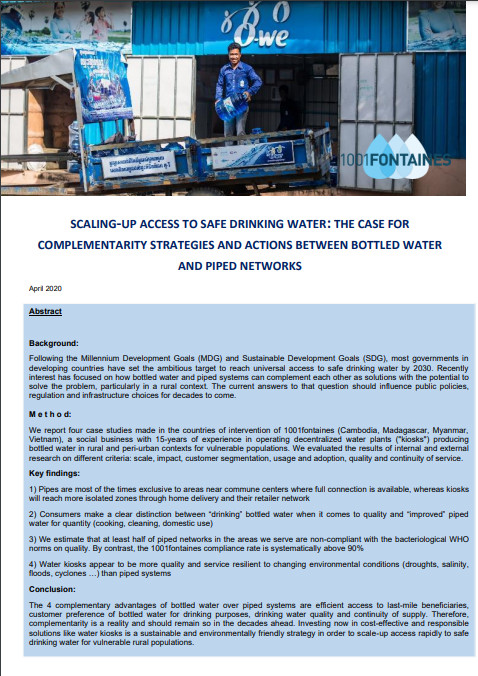Scaling-up access to safe drinking water: the case for complementarity strategies and actions between bottled water and piped networks
 |
note Apr 2020 ; 20 pages
Ed. 1001 fontaines - Paris
Téléchargeable sous format: PdF
Téléchargeable chez l'éditeur
Résumé:
En cohérence avec les Objectifs de Développement Durable (ODD), la plupart des gouvernements des pays en développement se sont fixé l'objectif ambitieux d'atteindre l'accès universel à l'eau potable d'ici 2030.
Ce document interroge deux solutions à même de contribuer à cet objectif: le système d'adduction d'eau courante et l'eau en bouteille, produite localement par des unités de potabilisation gérée au sein des communautés. Plus que d'être en concurrence, ces modèles apparaissent complémentaires: ils offrent des avantages différents et répondent à des besoins distincts. Ainsi, la combinaison de l'eau courante et de l'eau en bouteille pourrait, dans certaines circonstances, contribuer à accélérer la réalisation de l'accès universel à l'eau potable.
Abstract:
Following the Sustainable Development Goals (SDG), most governments in developing countries have set the ambitious target to reach universal access to safe drinking water by 2030. Recently interest has focused on how bottled water and piped systems can complement each other as solutions with the potential to solve the problem, particularly in a rural context. The current answers to that question should influence public policies, regulation and infrastructure choices for decades to come.
Method: We report four case studies made in the countries of intervention of 1001fontaines (Cambodia, Madagascar, Myanmar, Vietnam), a social business with 15-years of experience in operating decentralized water plants ("kiosks") producing bottled water in rural and peri-urban contexts for vulnerable populations. We evaluated the results of internal and external research on different criteria: scale, impact, customer segmentation, usage and adoption, quality and continuity of service.
Key findings:
1) Pipes are most of the times exclusive to areas near commune centers where full connection is available, whereas kiosks will reach more isolated zones through home delivery and their retailer network ;
2) Consumers make a clear distinction between “drinking” bottled water when it comes to quality and “improved” piped water for quantity (cooking, cleaning, domestic use) ;
3) We estimate that at least half of piped networks in the areas we serve are non-compliant with the bacteriological WHO norms on quality. By contrast, the 1001fontaines compliance rate is systematically above 90% ;
4) Water kiosks appear to be more quality and service resilient to changing environmental conditions (droughts, salinity, floods, cyclones …) than piped systems.
Conclusion: The 4 complementary advantages of bottled water over piped systems are efficient access to last-mile beneficiaries, customer preference of bottled water for drinking purposes, drinking water quality and continuity of supply. Therefore, complementarity is a reality and should remain so in the decades ahead. Investing now in cost-effective and responsible solutions like water kiosks is a sustainable and environmentally friendly strategy in order to scale-up access rapidly to safe drinking water for vulnerable rural populations.
Mots clefs: |
approvisionnement en eau (CI) (DT) (OP) (ope) , distribution d'eau potable (CI) (DT) (OP) (ope) |
Pays concernés: |
Birmanie-Myanmar (CI) (DT) (OP) , Cambodge (CI) (DT) (OP) , Madagascar (CI) (DT) (OP) , Vietnam (CI) (DT) (OP) |
Editeur/Diffuseur: |
|
1001 fontaines - Paris |
En cas de lien brisé, nous le mentionner à communication@pseau.org